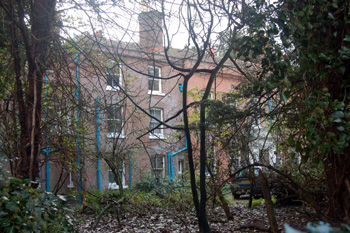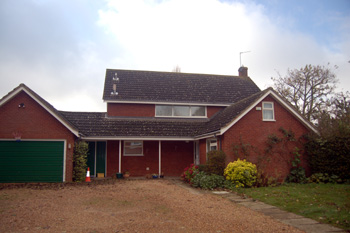Clifton Rectories
Rectory The First
Clifton has had no less than five rectories in the last three hundred years. The first record of a rectory house is in a glebe terrier of 1607 [ABE1] which described a house of six bays with six rooms downstairs comprising a hall, parlour, kitchen, buttery, larder and milkhouse and six chambers and a study above. Outside stood a brewhouse and bakehouse, both tiled, a seven bay barn and a thatched long house west of the gatehouse. A terrier of 1708 [ABEII page 85] seems to describe the same building - it was constructed of stud and clay plastered with lime and hair and had a tiled roof. Downstairs comprised a large hall and parlour, both with board floors, a kitchen with a brick floor, a buttery, milkhouse and "other little rooms" all with clay floors - "all have chambers over them" i.e. upstairs.

Clifton House from Church Street November 2009
Rectory The Second
A licence was issued to pull down this "ancient Rectory" on 6th June 1712 and the Rector, Philip Oddy in a return to the episcopal visitation of that year explained that he lived in Henlow because the Rectory was too new, presumably meaning that it was not yet finished. A terrier of 1745 [P7/2/1/2] describes this building thus: A Parsonage House built with brick and Tiled consisting of a large Hall, carved with stone, and three Parlors [sic] floored and wainscoted, as many Rooms over them, and two Garrets, a Cellar and Vault under it. Adjoining is a Kitchen, Pantry, Scullery and Servants' Hall paved with brick and Rooms over them; the South side and East end of this Building is Timber and roughcast, the rest is Brick. Cross a small yard pitched with pebbles and fenced with Oak Pails on the North and west is a Brewhouse and woodhouse of Timber and Clay, with a brick Necessary [i.e. a privy] adjoining eastward and a Bottle house lathed on the South, all Tiled. Adjoining to the House Eastward is a small Buttery of Brick and covered with Lead. The Farm yard is chiefly fenced with Buildings, next the Street are two Stables and Granary with a Straw barn between them, on the North is a Barn of seven Bays [perhaps left standing from the building of 1607] Tiled, part Boarded and part Timber and Brick, at the East end thereof is a Hovel, two Hogsties and Henhouse, Thatched, chiefly boarded, but the North side Timber and clay. Adjoining to which Eastward is a wheat Barn of four Bays Thatched and Boarded and at a small Distance is a Dove house of Timber and Clay plaister'd [sic] and Tiled. Before the House is a Court walled with Brick on both Sides and Pallisadoes [sic] next the Street to the South is a small fruit Garden walled. And on the Back of the House is a Kitchen Garden fenced with Oak pales on both sides and the East End with a Hedge and a few old pales adjoining to which is a Close of Pasture fenced with a Hedge on the North and Elm pales on the East by the Rector, and with a Hedge on the South by the corner of the Close adjoining. This Homestall above mentioned contains by estimation about two Acres".
Another description of the Rectory is found in a terrier of 1822 [P7/2/1/3]: "One Tiled dwelling house with double roof in length 61 Feet, in breadth 41 feet, the Kitchen end 33 feet within the walls, with pantry projecting from the same in length 10 feet in breadth 7 feet. One TiledBuilding containing Barn, table and Coach house in length 62 feet, in breadth 24 feet 6 inches with wash house at the end of the same, in length 25 feet, in breadth 15 feet 6 inches. A Tiled Green house with back towards the yard in length 14 ftxv6 inches, in breadth 10 feet, with shed at the back of the same covered with pan-tiles in length 11 feet 6 inches, in breadth 5 feet 6 inches, a privey [sic] near wash house covered with lead, 5 feet square, and another privey at the end of the barn covered with pantiles in length 6 feet in breadth 5 feet". From the evidence of the Inclosure Map of 1832 [MA59] it is clear that this Rectory is today's Clifton House.
Clifton House was listed by the former Ministry of Public Buildings and Works in October 1966 as Grade II, of special interest. The department reckoned it to be late 18th or early 19th century though, as we have seen, part of it at least probably dates to 1712. There are late 19th century additions and alterations. It is built of red brick and has clay tiled roofs. the original house has two storeys but there is a three storey extension to the north with additional two storey accommodation.

Listed outbuildings at Clifton House November 2009 surrounded by builders' detritus
The former coach house was listed in August 1985 as Grade II. It was built in the late 19th century of yellow brick with a hipped clay tile roof. It is of one storey with attics and was "included for group value".
The Rating and Valuation Act 1925 specified [Section 19 (1)] that every piece of land and property in the country be valued to determine the rateable value. Clifton, like most of Bedfordshire, was assessed in 1927 and the valuer visiting Clifton House noted that it was owned and occupied by Captain G. Dower. Downstairs accommodation comprised: a stone floored hall measuring 17 feet 6 inches by 20 feet 6 inches; a butler's pantry; a kitchen ("Light good"); a scullery ("poor"); a boiler room; a servants' hall; a larder; a cellar ("good"); a dining room measuring 15 feet 6 inches by 19 feet plus a bay of 8 feet by 5 feet and a lounge measuring 15 feet by 20 feet with a bay of 5 feet by 7 feet). Upstairs were two bedrooms, a bathroom ("very good"), two boxrooms, a further bathroom, a night nursery, two W. C.s, a day nursery and a house maid's closet. A double maids' bedroom and three single bedrooms lay on the second floor.
Outside stood a wood and stale five bay open shed, a two stall stable and a cow shed, all unused. The kitchen garden was walled and contained un unheated peach house measuring 40 feet by 15 feet. There was also a brick and tile claoshed with a loft over, a four stall stable and garage. In the grounds stood a bungalow occupied by the (unfortunately unnamed) gardener - it was brick and roghcast with asbestos tiles and contained living room, kitchen and bedroom. The valuer commented that the grounds were: "Well laid out. Nice lawn. Tennis. Rose garden". However the house was in a "bad social position" and was "not well arranged". It was lighted by gas and water was laid on.
In 1937 Clarice Joan Ward Gandar Dower conveyed Clifton House to Kathleen Ruthar Mary Fitz Roy, wife of Lord John Fitz Roy [PCClifton4/4]. By 1951 she had become Kathleen Carr and conveyed the house to Thomas Baker Raban of Knebworth [Hertfordshire], contractor [PCClifton4/4] and in 1975 he conveyed land to the parish council as an addition to the playing fields.
![Clifton Rectory about 1900 [Z50/30/29]](/CommunityHistories/Clifton/CliftonImages/Clifton Rectory about 1900 [Z50-30-29].jpg)
Clifton Rectory about 1900 [Z50/30/29]
Rectory The Third
A new Rectory was built between 1889 and1891 [[P7/2/4/1] adjacent to the church. The 25 inches to the mile First Edition Ordnance Survey map of 1882 shows a building already on the site, facing straight on to the road and this must have been demolished before the new Rectory could be built. In 1927 the Rectory was valued under the 1925 Rating Valuation Act. This act specified that every piece of land and building in the country was to be valued to determine the rates to be paid on it. The valuer discovered that the Rectory stood in 1.873 acres and comprised an entrance porch and a large hall with a tiled floor; at the south-east corner was a drawing room (19 feet by 15 feet) with a bay window; at the south-west was a recreation room (17 feet by 15 feet) with French windows leading onto the lawn and a W. C. leading from it; at the north-west corner was a kitchen ("large and good"); and at the south-east corner was a dining room (18 feet by 15 feet).
A staircase ("wide & good leading from Hall") went upstairs where there were: in the south-east corner a bedroom (15 feet square) with a linen cupboard; on the south face was a dressing room (10 feet by 9½ feet) and a bedroom (13½ feet by 12½ feet) with a lavatory and W. C. and a small bathroom; on the north-west corner was a bedroom (18 feet by 14 feet); and another bedroom lay on the south-east corner (18 feet by 15 feet). Here there was a back staircase ("narrow" with hot and cold water taps) up to the second floor with two bedrooms one at the north-west corner (18 feet by 15 feet) and one at the south-east corner (also 18 feet by 15 feet) as well as a large room measuring 40 feet by 15 feet with support posts in the centre and a "bad slope".
Outside was a courtyard, a lavatory and W. C., a two bay open shed, a coal cellar (capacity twenty tons), a small carpenter's shop, two small barns and a coke house. From here one went down to the garden which had an open cart shed and a garage for two cars as well as a harness room, a two stall stable, a small open barn, a loose box, a large washhouse and a drying room with a loft over. The garage, harness room and stable together measured 63 feet by 15 feet. There was also an earth closet. Of the grounds the valuer opined "Large Garden & Grounds well laid out and kept in good condition, good lawns for tennis etc". Electric light was installed in the house later that year [P7/2/4/8]. The Rectory and most of its site was sold by the Diocese in 1969 and had been demolished by the early 1970s after a life of about eighty years.

The well on the site of the former Rectory November 2009
The one building to remain is the well. Sir Nikolaus Pevsner in his Buildings of England volume on Bedfordshire describes it as "picturesque and debased".

13 Manor Close November 2009
Rectory The Fourth
A temporary rectory was found at 13 Manor Close [P7/2/4/12] after it was decided that the Victorian Rectory adjoining the churchyard would be sold. Manor Close served as the Rectory until 1976.

Clifton Rectory November 2009
Rectory The Fifth
Today's Rectory stands at 8 Rectory Close and was built in 1976 [P7/2/4/13]. It stands roughly on the site of the Kitchen Garden of the third Rectory.